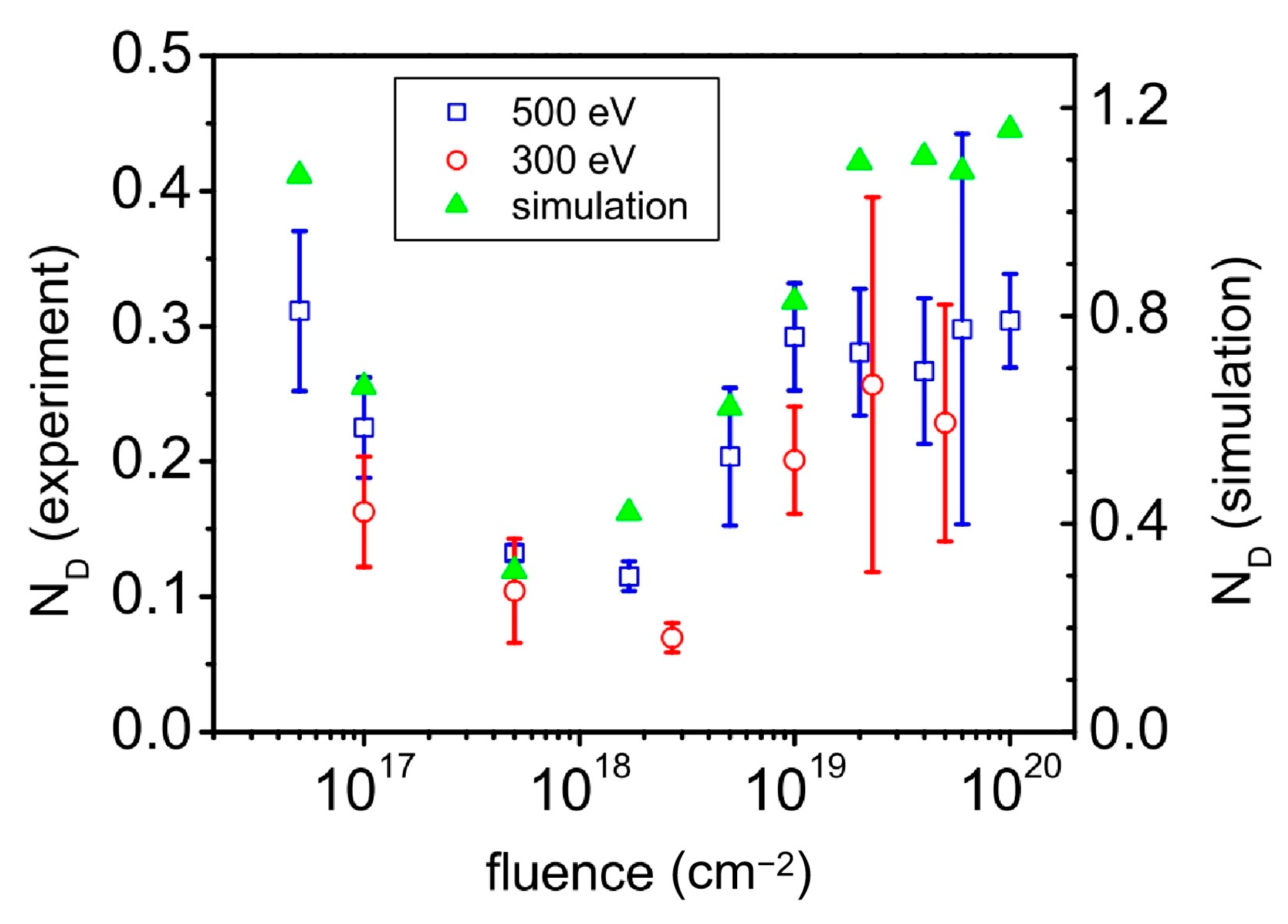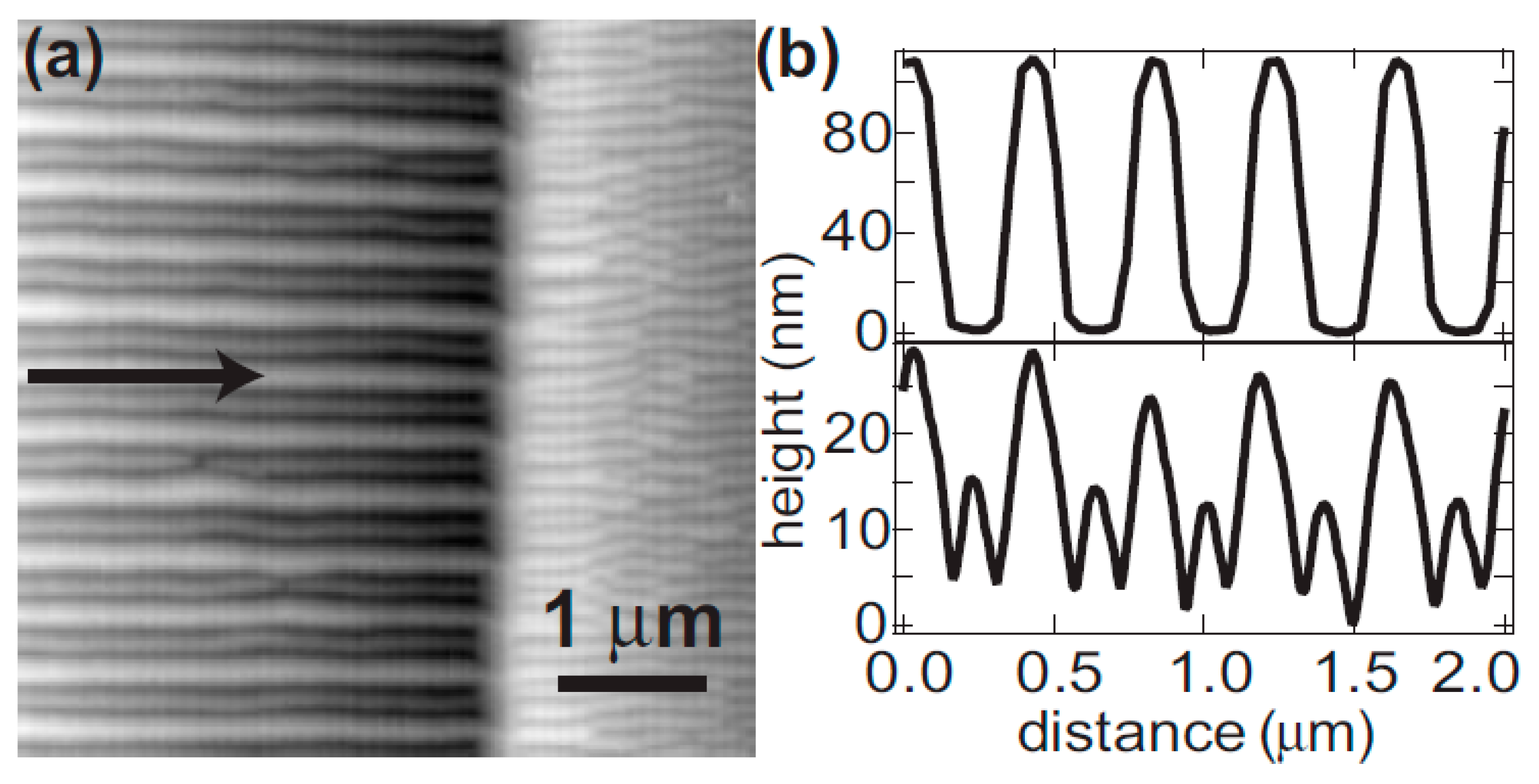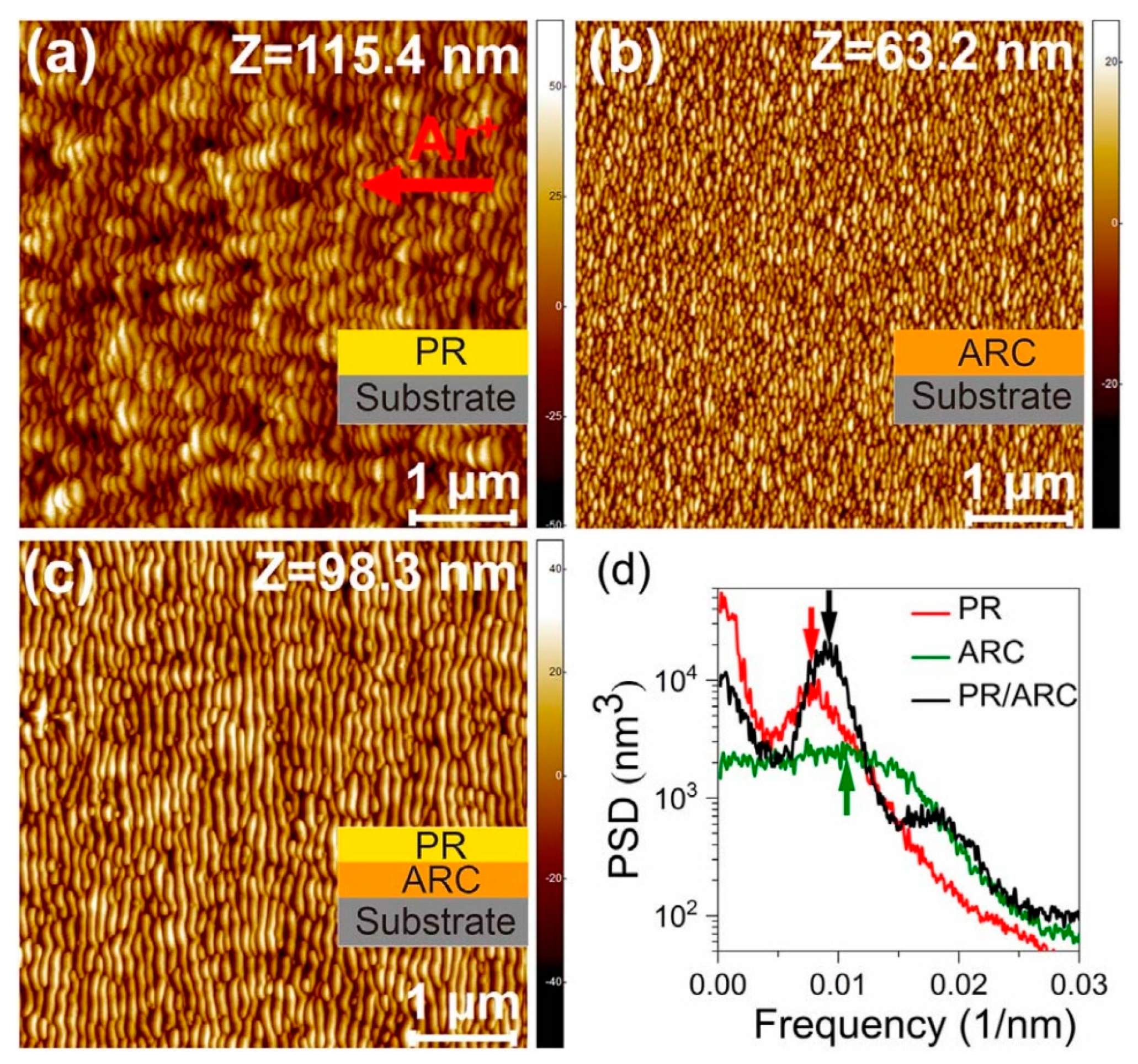Ordering Enhancement of Ion Bombardment-Induced Nanoripple Patterns: A Review
Abstract
1. Introduction
2. Conventional Ion Bombardment of Single Materials
2.1. Conventional IB of Initially Flat Si Surfaces
2.2. Conventional IB of Si with Periodic Prepatterns
3. Unconventional Ion Bombardment of Single Materials
3.1. Sequential IB
3.2. Dynamic (Rocking) Bombardment of Si and Amorphous-Carbon
4. Conventional Ion Bombardment of a Bilayer Material
- (a)
- The well-grown IB-induced nanoripples on the PR surface;
- (b)
- The ripple pattern transfers from the top layer of PR to the underlying layer of ARC. This indicates that the resultant ARC ripple patterns, transferred from those in the PR layer, act as self-organized prepatterns during the sequential bombardment of the ARC surface;
- (c)
- The evolution of the initial nonuniform ARC nanoripples into uniform ones. Considering the entire bombardment of the PR/ARC bilayer, a synergy of the pattern formation mechanisms includes pattern transfer using a sacrificial IB-induced, nanorippled mask in processes (a) and (b), and subsequent curvature-dependent sputtering based on the Bradley–Harper model [1] in process (c). In fact, the entire process rarely occurs concurrently during IB. Additionally, to achieve nanoripples with enhanced regularity, at least two conditions must be met. First, the ripple vector of the potential ripples (latent ripples on ARC) needs to be parallel to that of the existing ripples (ARC ripples transferred from the PR ripples). Second, the wavelength of the potential ripples should be close to that of the existing ripples.
5. Discussion
5.1. Understanding the Ordering Improvement from the Perspective of Ripple Superimposition
5.2. Understanding the Ordering Improvement from the Perspective of Guided Self-Organization
6. Conclusions
Supplementary Materials
Author Contributions
Funding
Acknowledgments
Conflicts of Interest
Disclosure Instructions
References
- Bradley, R.M.; Harper, J.M.E. Theory of ripple topography induced by ion bombardment. J. Vac. Sci. Technol. A 1988, 6, 2390–2395. [Google Scholar] [CrossRef]
- Chan, W.L.; Chason, E. Making waves: Kinetic processes controlling surface evolution during low energy ion sputtering. J. Appl. Phys. 2007, 101, 121301. [Google Scholar] [CrossRef]
- Frost, F.; Ziberi, B.; Schindler, A.; Rauschenbach, B. Surface engineering with ion beams: From self-organized nanostructures to ultra-smooth surfaces. Appl. Phys. A 2008, 91, 551–559. [Google Scholar] [CrossRef]
- Muñoz-García, J.; Vázquez, L.; Castro, M.; Gago, R.; Redondo-Cubero, A.; Moreno-Barrado, A.; Cuerno, R. Self-organized nanopatterning of silicon surfaces by ion beam sputtering. Mater. Sci. Eng. R Rep. 2014, 86, 1–44. [Google Scholar] [CrossRef]
- Norris, S.A.; Aziz, M.J. Ion-induced nanopatterning of silicon: Toward a predictive model. Appl. Phys. Rev. 2019, 6, 011311. [Google Scholar] [CrossRef]
- Hofsäss, H.; Bobes, O. Prediction of ion-induced nanopattern formation using Monte Carlo simulations and comparison to experiments. Appl. Phys. Rev. 2019, 6, 021307. [Google Scholar] [CrossRef]
- Cuerno, R.; Kim, J.S. A perspective on nanoscale pattern formation at surfaces by ion-beam irradiation. J. Appl. Phys. 2020, 128, 180902. [Google Scholar] [CrossRef]
- Vazquez, L.; Redondo-Cubero, A.; Lorenz, K.; Palomares, F.J.; Cuerno, R. Surface nanopatterning by ion beam irradiation: Compositional effects. J. Phys. Condens. Matter 2022, 34, 333002. [Google Scholar] [CrossRef]
- Lian, J.; Zhou, W.; Wei, Q.M.; Wang, L.M.; Boatner, L.A.; Ewing, R.C. Simultaneous formation of surface ripples and metallic nanodots induced by phase decomposition and focused ion beam patterning. Appl. Phys. Lett. 2006, 88, 093112. [Google Scholar] [CrossRef]
- Wei, Q.; Lian, J.; Boatner, L.A.; Wang, L.M.; Ewing, R.C. Propagation of ripples on pyrochlore induced by ion beam bombardment. Phys. Rev. B 2009, 80, 085413. [Google Scholar] [CrossRef]
- Li, P.; Chen, S.; Dai, H.; Yang, Z.; Chen, Z.; Wang, Y.; Chen, Y.; Peng, W.; Shan, W.; Duan, H. Recent advances in focused ion beam nanofabrication for nanostructures and devices: Fundamentals and applications. Nanoscale 2021, 13, 1529–1565. [Google Scholar] [CrossRef]
- Bachurin, V.I.; Smirnova, M.A.; Lobzov, K.N.; Lebedev, M.E.; Mazaletsky, L.A.; Pukhov, D.E.; Churilov, A.B. Wavelike periodic structures on the Silicon surface initiated by irradiation with a focused Gallium ion beam. J. Surf. Investig. X-Ray Synchrotron Neutron Tech. 2024, 18, 822–833. [Google Scholar] [CrossRef]
- Windisch, M.; Selmeczi, D.; Vida, A.; Dankhazi, Z. Investigation of ripple formation on surface of Silicon by low-energy Gallium ion bombardment. Nanomaterials 2024, 14, 1124. [Google Scholar] [CrossRef]
- Camellini, A.; Mazzanti, A.; Mennucci, C.; Martella, C.; Lamperti, A.; Molle, A.; Buatier de Mongeot, F.; Della Valle, G.; Zavelani-Rossi, M. Evidence of plasmon enhanced charge transfer in large-area hybrid Au–MoS2 metasurface. Adv. Opt. Mater. 2020, 8, 2000653. [Google Scholar] [CrossRef]
- Saini, M.; Augustine, S.; Ranjan, M.; Som, T. In-plane optical anisotropy and SERS detection efficiency of self-organized gold nanoparticles on silicon nanoripples: Roles of growth angle and postgrowth annealing. Appl. Surf. Sci. 2020, 512, 145703. [Google Scholar] [CrossRef]
- Giordano, M.C.; Pham, L.D.; Ferrando, G.; Nguyen, H.S.; Le, C.H.; Mai, T.-H.; Zambito, G.; Gardella, M.; Buatier de Mongeot, F. Self-organized plasmonic nanowire arrays coated with ultrathin TiO2 films for photoelectrochemical energy storage. ACS Appl. Nano Mater. 2023, 6, 21579–21586. [Google Scholar] [CrossRef] [PubMed]
- Lamba, T.K.; Augustine, S.; Saini, M.; Sooraj, K.P.; Ranjan, M. LSPR anisotropy minimization by sequential growth of Ag nanoparticles on nanoripple patterned Si surface for SERS Application. Surf. Interfaces 2024, 52, 104852. [Google Scholar] [CrossRef]
- Kratzer, M.; Szajna, K.; Wrana, D.; Belza, W.; Krok, F.; Teichert, C. Fabrication of ion bombardment induced rippled TiO2 surfaces to influence subsequent organic thin film growth. J. Phys. Condens. Matter 2018, 30, 283001. [Google Scholar] [CrossRef]
- Giordano, M.C.; Sacco, F.d.; Barelli, M.; Portale, G.; Buatier de Mongeot, F. Self-organized tailoring of faceted glass nanowrinkles for organic nanoelectronics. ACS Appl. Nano Mater. 2021, 4, 1940–1950. [Google Scholar] [CrossRef]
- Mennucci, C.; Del Sorbo, S.; Pirotta, S.; Galli, M.; Andreani, L.C.; Martella, C.; Giordano, M.C.; de Mongeot, F.B. Light scattering properties of self-organized nanostructured substrates for thin-film solar cells. Nanotechnology 2018, 29, 355301. [Google Scholar] [CrossRef]
- Gupta, D.; Chhoker, K.; Rani, U.; Salim, A.; Singhal, R.; Sharma, V.; Aggarwal, S. Fabrication of Ripple Structured Silicon Carbide (SiC) Films for Nano-Grating and Solar Cell Applications. ChemNanoMat 2024, 11, 202400455. [Google Scholar] [CrossRef]
- Kaur, D.; Rakhi; Posti, R.; Singh, J.; Roy, D.; Sarkar, S.; Kumar, M. Nanopatterning Induced Si Doping in Amorphous Ga2O3 for Enhanced Electrical Properties and Ultra-Fast Photodetection. Small 2024, 20, 2309277. [Google Scholar] [CrossRef] [PubMed]
- Barelli, M.; Ferrando, G.; Giordano, M.C.; Buatier de Mongeot, F. Wavelength-Dependent Plasmonic Photobleaching of Dye Molecules by Large-Area Au Nanostripe Arrays. ACS Appl. Nano Mater. 2022, 5, 3470–3479. [Google Scholar] [CrossRef]
- Arranz, M.A.; Colino, J.M.; Palomares, F.J. On the limits of uniaxial magnetic anisotropy tuning by a ripple surface pattern. J. Appl. Phys. 2014, 115, 183906. [Google Scholar] [CrossRef]
- Bera, A.K.; Dev, A.S.; Kumar, D. Enhancing the limit of uniaxial magnetic anisotropy induced by ion beam erosion. Appl. Phys. Lett. 2023, 122, 022405. [Google Scholar] [CrossRef]
- Yang, Y.; Keller, A. Ion beam nanopatterning of biomaterial surfaces. Appl. Sci. 2021, 11, 6575. [Google Scholar] [CrossRef]
- Garcia, M.A.; Gago, R.; Arroyo-Hernández, M.; de Laorden, E.H.; Iglesias, M.; Esteban-Mendoza, D.; Cuerno, R.; Rickards, J. Texturization of polycrystalline titanium surfaces after low-energy ion-beam irradiation: Impact on biocompatibility. Surf. Coat. Technol. 2023, 458, 129363. [Google Scholar] [CrossRef]
- Pachchigar, V.; Parida, B.K.; Augustine, S.; Hans, S.; Saini, M.; Sooraj, K.P.; Ranjan, M. Comparative wettability study of bulk and thin film of polytetrafluoroethylene after low energy ion irradiation. Thin Solid Film. 2023, 777, 139888. [Google Scholar] [CrossRef]
- Vandana; Kumar, T.; Ojha, S.; Kumar, S. Energy-dependent surface nanopatterning of Si (100) for different projectiles: A tunable anisotropic wettability of ripple surface. Appl. Nanosci. 2021, 13, 3189–3196. [Google Scholar] [CrossRef]
- Hans, S.; Parida, B.K.; Augustine, S.; Pachchigar, V.; Sooraj, K.P.; Ranjan, M. Anisotropic wettability transition on nanoterraced glass surface by Ar ions. J. Mater. Sci. 2024, 59, 14205–14223. [Google Scholar] [CrossRef]
- Jacak, W.A. Quantum Nano-Plasmonics; Cambridge University Press: Cambridge, UK, 2020; pp. 1–16. [Google Scholar]
- Luo, P.; Jaramillo, C.; Wallum, A.M.; Liu, Z.; Zhao, R.; Shen, L.; Zhai, Y.; Spear, J.C.; Curreli, D.; Lyding, J.W.; et al. Coherent Atomic-Scale Ripples on Metallic Glasses Patterned by Low-Energy Ion Irradiation for Large-Area Surface Structuring. ACS Appl. Nano Mater. 2020, 3, 12025–12033. [Google Scholar] [CrossRef]
- Buatier de Mongeot, F.; Valbusa, U. Applications of metal surfaces nanostructured by ion beam sputtering. J. Phys. Condens. Matter 2009, 21, 224022. [Google Scholar] [CrossRef]
- Seo, J.; Pearson, D.A.; Bradley, R.M.; Kim, J.S. Nanoscale pattern formation on silicon surfaces bombarded with a krypton ion beam: Experiments and simulations. J. Phys. Condens. Matter 2022, 34, 265001. [Google Scholar] [CrossRef]
- Rüdiger, T.; Mitzschke, M.; Bundesmann, C.; Prager, A.; Liu, Y.; Abel, B.; Schulze, A.; Frost, F. Ion incidence angle-dependent pattern formation on AZ® 4562 photoresist by reactive ion beam etching. Surf. Coat. Technol. 2024, 494, 131407. [Google Scholar] [CrossRef]
- Carter, G. Proposals for producing novel periodic structures by ion bombardment sputtering. Vacuum 2004, 77, 97–100. [Google Scholar] [CrossRef]
- Carter, G. Surface ripple amplification and attenuation by sputtering with diametrically opposed ion fluxes. Vacuum 2005, 79, 106–109. [Google Scholar] [CrossRef]
- Vogel, S.; Linz, S.J. Surface structuring by multiple ion beams. Phys. Rev. B 2007, 75, 085425. [Google Scholar] [CrossRef]
- Joe, M.; Choi, C.; Kahng, B.; Kim, J.-S. Nanopatterning by dual-ion-beam sputtering. Appl. Phys. Lett. 2007, 91, 233115. [Google Scholar] [CrossRef]
- Joe, M.; Kim, J.H.; Choi, C.; Kahng, B.; Kim, J.S. Nanopatterning by multiple-ion-beam sputtering. J. Phys. Condens. Matter 2009, 21, 224011. [Google Scholar] [CrossRef]
- Kim, J.H.; Joe, M.; Kim, S.P.; Ha, N.B.; Lee, K.R.; Kahng, B.; Kim, J.S. Pattern evolution on previously rippled Au(001) by crossing-ion-beam sputtering. Phys. Rev. B 2009, 79, 205403. [Google Scholar] [CrossRef]
- Kim, J.H.; Kim, J.-S.; Muñoz-García, J.; Cuerno, R. Role of nonlinearities and initial prepatterned surfaces in nanobead formation by ion-beam bombardment of Au(001): Experiments and theory. Phys. Rev. B 2013, 87, 085438. [Google Scholar] [CrossRef]
- Muñoz-García, J.; Cuerno, R.; Castro, M. Coupling of morphology to surface transport in ion-beam irradiated surfaces: Oblique incidence. Phys. Rev. B 2008, 78, 205408. [Google Scholar] [CrossRef]
- Prokopenko, M. Guided self-organization. HFSP J. 2009, 3, 287–289. [Google Scholar] [CrossRef]
- Araujo, N.A.M.; Janssen, L.M.C.; Barois, T.; Boffetta, G.; Cohen, I.; Corbetta, A.; Dauchot, O.; Dijkstra, M.; Durham, W.M.; Dussutour, A.; et al. Steering self-organisation through confinement. Soft Matter 2023, 19, 1695–1704. [Google Scholar] [CrossRef]
- Li, H.; Li, J.; Yang, G.; Liu, Y.; Frost, F.; Hong, Y. Can one series of self-organized nanoripples guide another series of self-organized nanoripples during ion bombardment: From the perspective of power spectral density entropy? Entropy 2023, 25, 170. [Google Scholar] [CrossRef]
- Keller, A.; Facsko, S.; Möller, W. Minimization of topological defects in ion-induced ripple patterns on silicon. New J. Phys. 2008, 10, 063004. [Google Scholar] [CrossRef]
- Ziberi, B.; Cornejo, M.; Frost, F.; Rauschenbach, B. Highly ordered nanopatterns on Ge and Si surfaces by ion beam sputtering. J. Phys. Condens. Matter 2009, 21, 224003. [Google Scholar] [CrossRef] [PubMed]
- Keller, A.; Facsko, S. Tuning the quality of nanoscale ripple patterns by sequential ion-beam sputtering. Phys. Rev. B 2010, 82, 155444. [Google Scholar] [CrossRef]
- Gelfand, M.P.; Bradley, R.M. Highly ordered nanoscale patterns produced by masked ion bombardment of a moving solid surface. Phys. Rev. B 2012, 86, 121406(R). [Google Scholar] [CrossRef]
- Harrison, M.P.; Bradley, R.M. Producing virtually defect-free nanoscale ripples by ion bombardment of rocked solid surfaces. Phys. Rev. E 2016, 93, 040802. [Google Scholar] [CrossRef]
- Jo, S.; Jun, J.; Lee, E.; Yoon, S.M.; Seo, J.; Muñoz-García, J.; Cuerno, R.; Kim, J.S. Order improvement of surface nanopatterns via substrate rocking under ion bombardment: Experiments and nonlinear models. Phys. Rev. B 2020, 102, 045421. [Google Scholar] [CrossRef]
- Rakhi; Muñoz-García, J.; Cuerno, R.; Sarkar, S. Towards ordered Si surface nanostructuring: Role of an intermittent ion beam irradiation approach. Phys. Scr. 2023, 98, 055902. [Google Scholar] [CrossRef]
- Cuenat, A.; George, H.B.; Chang, K.C.; Blakely, J.M.; Aziz, M.J. Lateral templating for guided self-organization of sputter morphologies. Adv. Mater. 2005, 17, 2845–2849. [Google Scholar] [CrossRef]
- Li, J.; Yang, G.; Bradley, R.M.; Liu, Y.; Frost, F.; Hong, Y. Enhancing the quality of self-organized nanoripples by Ar-ion bombardment of a bilayer system. Nanotechnology 2021, 32, 385301. [Google Scholar] [CrossRef] [PubMed]
- Cuerno, R.; Barabási, A.-L. Dynamic scaling of ion-sputtered surfaces. Phys. Rev. Lett. 1995, 74, 4746–4749. [Google Scholar] [CrossRef]
- Hecht, E.; Zajac, A. Optics, 2nd ed.; Addison-Wesley Publishing Company, Inc.: Reading, MA, USA, 1974; pp. 219, 279–280. [Google Scholar]
- Kazazis, D.; Santaclara, J.G.; von Schoot, J.; Mochi, I.; Ekinci, Y. Extreme ultraviolet lithography. Nat. Rev. Methods Primers 2024, 4, 84. [Google Scholar] [CrossRef]
- Yamada, I. Materials processing by gas cluster ion beams. Mater. Sci. Eng. R Rep. 2001, 34, 231–295. [Google Scholar] [CrossRef]
- Tilakaratne, B.; Chen, Q.; Chu, W.-K. Self-Assembled Gold Nano-Ripple Formation by Gas Cluster Ion Beam Bombardment. Materials 2017, 10, 1056. [Google Scholar] [CrossRef]
- Toyoda, N.; Tilakaratne, B.; Saleem, I.; Chu, W.-K. Cluster beams, nano-ripples, and bio applications. Appl. Phys. Rev. 2019, 6, 020901. [Google Scholar] [CrossRef]
- Pelenovich, V.; Zeng, X.; Rakhimov, R.; Zuo, W.; Tian, C.; Fu, D.; Yang, B. Decoration of ZnO needles with nanoripples using gas cluster ion bombardment. Mater. Lett. 2020, 264, 127356. [Google Scholar] [CrossRef]
- Ieshkin, A.; Kireev, D.; Ozerova, K.; Senatulin, B. Surface ripples induced by gas cluster ion beam on copper surface at elevated temperatures. Mater. Lett. 2020, 272, 127829. [Google Scholar] [CrossRef]
- Jiménez-Sáez, J.C.; Muñoz, S.; Palacios, P. Surface Ripple Formation by Bombardment with Clusters: Influence of Mass. Appl. Sci. 2024, 14, 4127. [Google Scholar] [CrossRef]





| Samples | Conventional Bombardment | Unconventional Bombardment | |
|---|---|---|---|
| Material | Initial Surface | ||
| Single material: Si | flat surface | Optimization of ion fluence [47] | Rocking [51,52], relevant to ripple superposition |
| Moving [50], only theoretical study available | |||
| Sequential ion bombardment [49] | |||
| Intermittent [53] | |||
| non-flat surface (i.e., prepatterned surface) | Grating-prepatterned surface [54], relevant to guided self-organization | ||
| Bilayer systems | flat surface | Photoresist/antireflection coating [55], relevant to ripple superposition and guided self-organization | |
Disclaimer/Publisher’s Note: The statements, opinions and data contained in all publications are solely those of the individual author(s) and contributor(s) and not of MDPI and/or the editor(s). MDPI and/or the editor(s) disclaim responsibility for any injury to people or property resulting from any ideas, methods, instructions or products referred to in the content. |
© 2025 by the authors. Licensee MDPI, Basel, Switzerland. This article is an open access article distributed under the terms and conditions of the Creative Commons Attribution (CC BY) license (https://creativecommons.org/licenses/by/4.0/).
Share and Cite
Liu, Y.; Li, H.; Wang, C.; Yang, G.; Frost, F.; Hong, Y. Ordering Enhancement of Ion Bombardment-Induced Nanoripple Patterns: A Review. Nanomaterials 2025, 15, 438. https://doi.org/10.3390/nano15060438
Liu Y, Li H, Wang C, Yang G, Frost F, Hong Y. Ordering Enhancement of Ion Bombardment-Induced Nanoripple Patterns: A Review. Nanomaterials. 2025; 15(6):438. https://doi.org/10.3390/nano15060438
Chicago/Turabian StyleLiu, Ying, Hengbo Li, Chongyu Wang, Gaoyuan Yang, Frank Frost, and Yilin Hong. 2025. "Ordering Enhancement of Ion Bombardment-Induced Nanoripple Patterns: A Review" Nanomaterials 15, no. 6: 438. https://doi.org/10.3390/nano15060438
APA StyleLiu, Y., Li, H., Wang, C., Yang, G., Frost, F., & Hong, Y. (2025). Ordering Enhancement of Ion Bombardment-Induced Nanoripple Patterns: A Review. Nanomaterials, 15(6), 438. https://doi.org/10.3390/nano15060438







